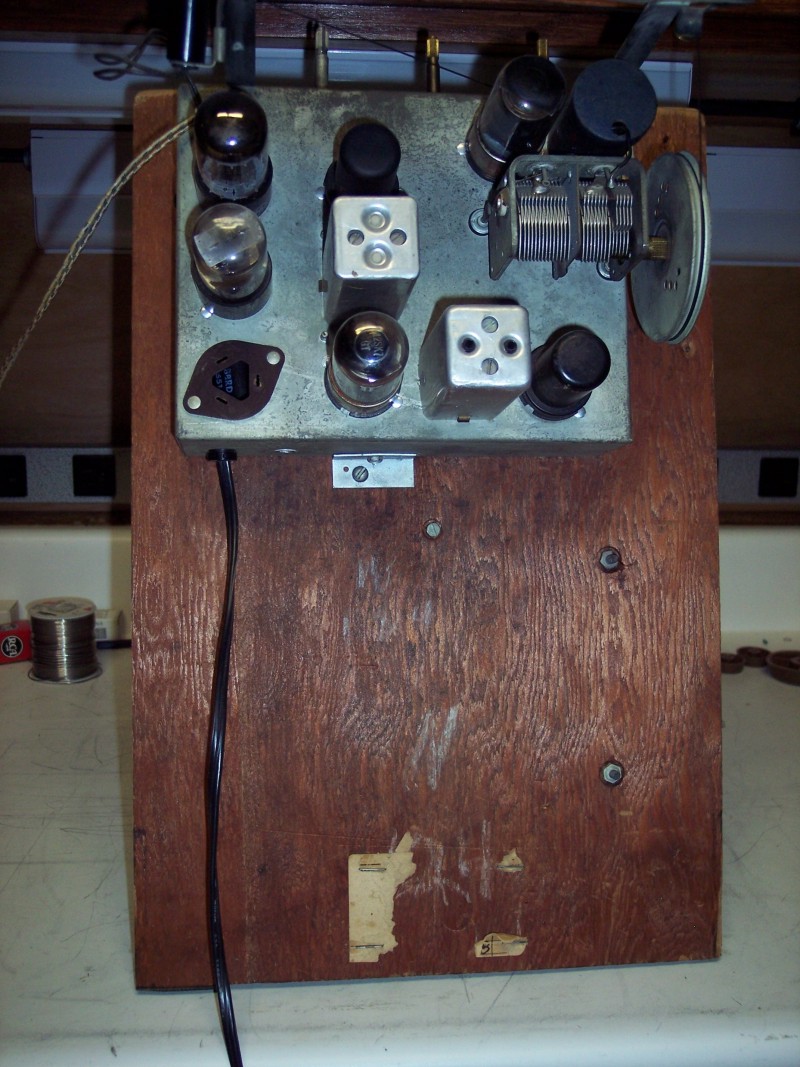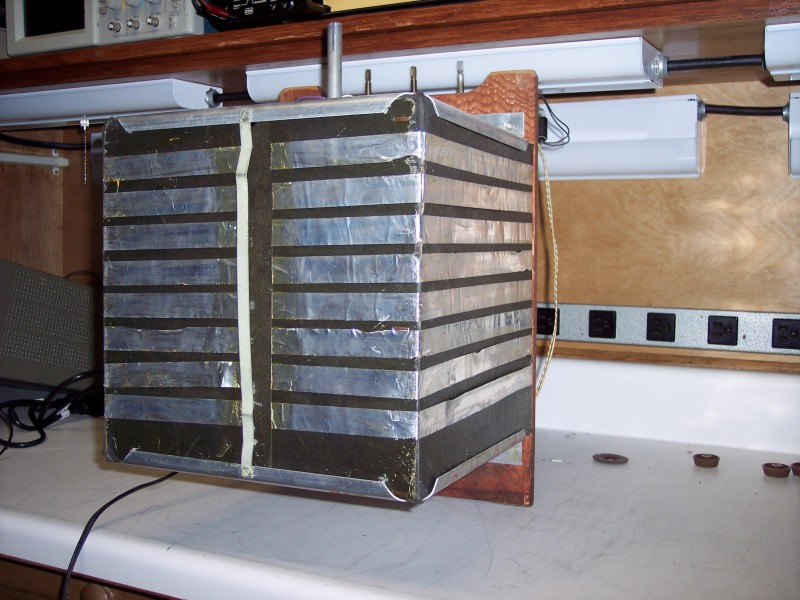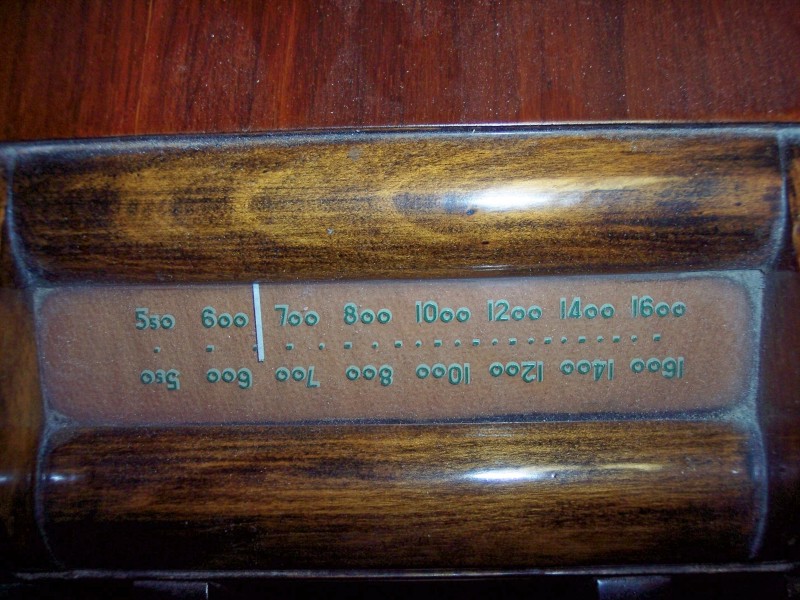
Photograph of Radio.
What started out to be a mystery turned out to be a coin operated hotel radio. Because this radio is so unique I have decided to leave this page up with a different title and a few changes. There is plenty of information about it here. I have no way of knowing how long this link will be alive so I will summarize.It appears to be a "Hotel Radio Corporation" model 6A. This was a coin activated radio. After the end of World War II the owners of high rise hotels received complaints from guests that radio reception in the rooms was very poor. The problem was a combination of weak signals due to the structural steel in the building combined with electrical interference. The HRC was formed to design and manufacture a radio with an RF stage and very good immunity to electromagnetic interference. The head of the HRC was a man named Frawley. Some of the radios sold by the Hotel Radio Co. had the Frawley brand name on a decal. The rest of them carried the name of the hotel they were sold to.
That mysterious brass plate covers the hole that had been cut for the coin device. There were two models made, one with the coin device and another without. The one I have may have been one made without the coin device or someone removed it before it came into my hands. The plate looks too good to be an amateur job so I assume it was original equipment. There are remains of paint on the plate as if someone tried to polish the brass and ended up removing the paint.
The radio was intended to be a chair side radio. Remember that it was made in the era before television when people would spend an evening listening to radio. The upside down markings on the dial seem to be intended for reading by someone sitting in an easy chair next to the radio.
History and Inner Workings.
Several years ago I was in an antique store in Scottsville Kentucky where I saw a radio that was too small to be a console and seemed a little too big to be a table model. There was no manufacturer's name visible on the outside.

Photograph of Radio.
What was so intriguing about it was one of the knobs. In addition to the usual "Volume", "On/Off /Tone", and "Tuning", it had a knob that was larger than the others labeled "Adjust for Best Reception".

Photograph of Radio's Control Panel.
The man said he didn't know what the knob did, the radio didn't work and he had never heard it work. The price was very reasonable for a wood radio so I bought it. When I got it home the first thing I did was to take a careful look inside. It turned out to be an All American 6.

Photograph of Underside of Radio.
I plugged it in and turned it on. Note: That is not advisable but this was before I developed the cautious approach I now use with such radios. It had the characteristic hum of an open filter capacitor so I started taking it apart.

Photograph of Insides of Radio.
To my great disappointment the paper label which had bin stapled to the board had been torn away.


Photograph of Antenna Box.
I had already guessed that the big knob controlled a rotating loop antenna and I was right but there turned out to be more to it than that. The loop is electrostaticly shielded. To allow the magnetic field to penetrate the box and induce a current in the loop there must not be a complete current path around the box. If there were it would be like a shorted turn in a transformer and there would be little signal induced in the loop. The horizontal strips of aluminum foil are broken on one side of the box. The bar in the bottom picture ties the top and bottom aluminum sheets together but it does not contact the foil strips.

Photograph of Loop Shaft Showing Insulator.
If the shaft were in electrical contact with both the top and bottom it would make a shorted turn with the tie bar. Where the shaft passes through the top plate a phonolic insulator prevents contact. On the bottom a spring ensures good contact to prevent static when the shaft is turned.
I replaced the filter capacitor and the radio sort of worked but I knew that given its RF stage and the large loop antenna it should have better sensitivity than it did.

Photograph of Loop Antenna.
The box is made of an insulating material that is a very dark gray on the outside but inside the box it is a much lighter gray. It appears to be a heavy gauge version of Fish Paper. In the picture it could be taken for sheet aluminum but it is not.
When I arrived at this stage in my initial disassembly I found that the wire that connects the loop back to the radio chassis was extremely tired. Many years of use and metal fatigue had taken its toll. I replaced it with stranded wire which will probably have to be replaced again someday.
As you can see the phonolic insulators in the middle of the loop extend beyond the loop on one end. This extension hits a screw which is visible in the picture and limits the rotation of the loop to 360 degrees. Well maybe 359.
There is one more odd thing about this radio.

Photograph Showing Slide Rule Dial.
It was designed to be a chair side radio. The upside down scale would permit the listener to have a frequency scale that would be right side up from his point of view.
The main reason why the designers of this radio were not facing any size restrictions was, it would be difficult for a customer to steal it and successfully smuggle it out of the hotel. The designers were able to produce a radio with superior performance.
This is without a doubt the best performing AM radio I have ever encountered. No doubt it was quite expensive for its day and probably very few were sold to private owners. Even the hotel market was likely rather small and, apparently, few from that source have survived making it rare.
When the radio came into my hands there was no sign that there had ever been a coin mechanism installed. It may have been removed by a previous owner or possibly there never was one. Information and photos on the pages referenced at the top of this page seem to indicate that the coin operated versions were painted while the free ones were in varnished wood. But don't hold me to that. Why the brass plate has nothing comprehensible on it is a complete mystery to me and your guess is as good as mine.